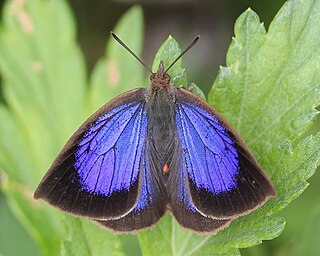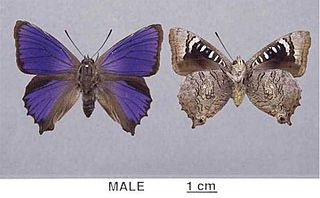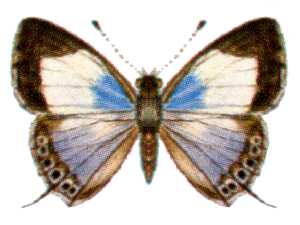
Arhopala centaurus, the centaur oakblue or dull oakblue, is a species of lycaenid or blue butterfly found in India and southeast Asia to the Philippines.

Arhopala silhetensis, the Sylhet oakblue, is a small butterfly found in India that belongs to the lycaenids or blues family. The species was first described by William Chapman Hewitson in 1862.

Arhopala is a very large genus of gossamer-winged butterflies (Lycaenidae). They are the type genus of the tribe Arhopalini. In the relatively wide circumscription used here, it contains over 200 species collectively known as oakblues. They occur from Japan throughout temperate to tropical Asia south and east of the Himalayas to Australia and the Solomon Islands of Melanesia. Like many of their relatives, their caterpillars are attended and protected by ants (myrmecophily). Sexual dichromatism is often prominent in adult oakblues.

Neolucia is a genus of butterflies in the family Lycaenidae. The three species of this genus are endemic to Australia and Tasmania.

Ogyris is an Australasian genus of butterflies in the family Lycaenidae.

Arhopala madytus, the bright oakblue, is a butterfly of the family Lycaenidae. The species was first described by Hans Fruhstorfer in 1914. It is found on New Guinea and adjacent islands and the north-east coast of Queensland, Australia.

Arhopala micale, the common oakblue or shining oakblue, is a butterfly of the family Lycaenidae. The species comprises about 16 subspecies, which are found in Melanesia and New Guinea as well as the north coast of Australia.

Jameela palmyra, the marbled blue, is a butterfly in the family Lycaenidae. It is found in along the coast of Australia, as well as in Indonesia, New Guinea and the Solomon Islands.

Arhopala atosia is a species of butterfly belonging to the lycaenid family described by William Chapman Hewitson in 1869. It is found in Southeast Asia - Borneo, Sumatra, Bangka, Pulau Laut, Thailand, Indochina, Peninsular Malaya, Singapore, Burma, Langkawi, Mergui and Palawan.

Arhopala delta is a species of butterfly belonging to the lycaenid family described by William Harry Evans in 1957. It is found in Southeast Asia.

Arhopala lurida is a species of butterfly belonging to the lycaenid family. It is found in Southeast Asia

Arhopala zambra, the Zambra oakblue, is a species of butterfly belonging to the lycaenid family described by Charles Swinhoe in 1911. It is found in Southeast Asia.

Arhopala admete is a butterfly in the family Lycaenidae. It was described by William Chapman Hewitson in 1863. It is found in the Australasian realm,

Arhopala auxesia is a butterfly in the family Lycaenidae. It was described by William Chapman Hewitson in 1863. It is found in New Guinea and Sumatra. The upper surface of the male is of a bright light bluish-green with a broad dark marginal band, the female dark violettish-blue, with a still broader margin. Beneath distinguished by the spots of the hindwing being also very prominently dark brown.

Arhopala eurisus is a butterfly in the family Lycaenidae. It was described by Hamilton Herbert Druce in 1891. It is found in the Australasian realm . It is recognisable by the lighter and more silvery tint of the upper surface in both sexes; otherwise rather similar to philander.

Arhopala azenia is a butterfly in the family Lycaenidae. It was described by William Chapman Hewitson in 1863. It is found in the Australasian realm.

Arhopala eucolpis is a butterfly in the family Lycaenidae. It was described by Theodor Franz Wilhelm Kirsch in 1877. It is found in the Australasian realm. It may be a subspecies of Arhopala admete.

Arhopala aexone is a species of butterfly in the family Lycaenidae. It was first described by William Chapman Hewitson in 1863. It is found in the Australasian realm.


















